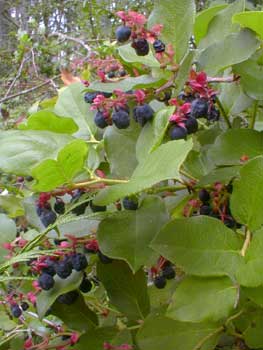 This is Salal and it has these little black berries. They apparently are good to eat. At least my 2 year old thought they were. It is a native to Washington plant.
This is Salal and it has these little black berries. They apparently are good to eat. At least my 2 year old thought they were. It is a native to Washington plant. According to King County: The single best ground cover for northwest gardens, salal is a do it all plant. Long recognised as one of the best foliage plants for flower arranging, it is also one of the most adaptable in the native repertoir. It can be grown short, if pruned back, hedged into wave like drifts, allowed to grow rampant and irregular to five feet or more. It will also grow where almost nothing else will, in deep understory forest groves, moist or dry soils, in full sun or deep shade. It does have a harder time in full sun, but if well watered or near the coast, it can survive. It does not transplant well, but it is generally available at garden centers.
It is edible: Its dark blue "berries" (actually swollen sepals[1]) and young leaves are both edible and are efficient appetite suppressants, both with a unique flavor. Salal berries were a significant food resource for native people, who both ate them fresh and dried them into cakes. They were also used as a sweetener, and the Haida used them to thicken salmon eggs. The leaves of the plant were also sometimes used to flavor fish soup.[1]
More recently, salal berries are used locally in jams, preserves and pies.[1][3] They are often combined with Oregon-grape because the tartness of the latter makes up for the mild sweetness of salal.
More recently, salal berries are used locally in jams, preserves and pies.[1][3] They are often combined with Oregon-grape because the tartness of the latter makes up for the mild sweetness of salal.
No comments:
Post a Comment